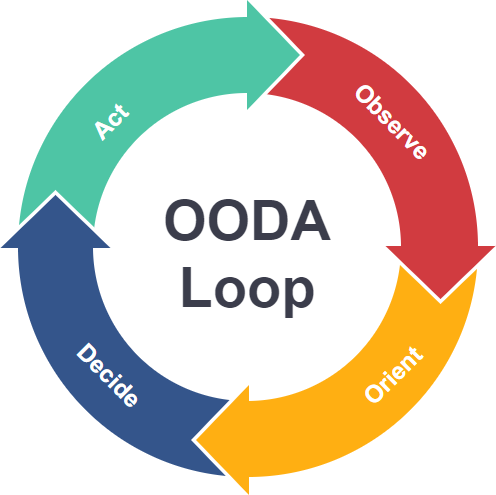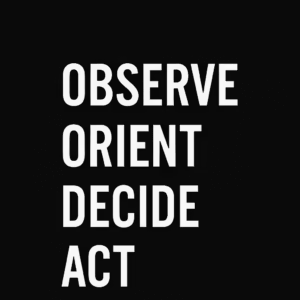Introduction: The Power of a Clear Mind
Ever feel like life is coming at you too fast? Whether it’s toddler tantrums, work deadlines, or even just choosing what to eat—it’s easy to fall into reactive patterns. Lately, I’ve been searching for tools to help me slow down and respond more intentionally. That’s when I stumbled on something called the OODA Loop. It’s a decision-making framework developed by a fighter pilot—but don’t worry, you don’t need a jet to use it.
In this post, I’ll break down what the OODA loop is, where it comes from, who can benefit from it, and how to apply it to everyday life—no tactical gear required.
What Is the OODA Loop?
The OODA loop is a four-step decision-making process that stands for:
-
Observe
-
Orient
-
Decide
-
Act
This loop helps you analyze your situation, make informed choices, and adapt quickly. It’s designed to be repeated as needed, so you’re constantly learning and improving with each cycle.
Where Did the OODA Loop Come From?
The OODA loop was created by Colonel John Boyd, a U.S. Air Force fighter pilot and military strategist. Originally, it was used to help pilots gain a competitive edge in high-stakes dogfights—by observing their environment faster, adjusting to new information, and outmaneuvering opponents.
But over time, the OODA loop has been adopted in other fields—business, sports, emergency response, and even personal development—because it works in any situation where quick, clear thinking is essential.
Who Should Use the OODA Loop?
You don’t need to be a CEO or a soldier to use the OODA loop. It’s useful for:
-
Busy parents trying to make better choices under pressure
-
Students needing to adapt to changing schedules or tough classes
-
Professionals who want to handle challenges with more clarity
-
Anyone looking to develop a healthier, more mindful mindset
In short, if you ever make decisions (hint: that’s all of us), you can benefit from this tool.
How to Apply the OODA Loop in Real Life
Let’s look at a simple everyday example: trying to stop a bad habit, like doomscrolling before bed.
1. Observe
Notice what’s actually happening.
“I always grab my phone when I lie in bed, telling myself I’ll just check one thing… and an hour later, I’m still scrolling.”
2. Orient
Reflect on why this is happening. What patterns or triggers are influencing your behavior?
“I do this when I feel too wired to sleep. It’s a distraction, but it leaves me feeling worse.”
3. Decide
Make a small, actionable decision.
“I’ll leave my phone across the room and keep a book by my bed instead.”
4. Act
Put the decision into motion.
Move the phone. Pick a book. Climb into bed.
Then, repeat the loop:
Did it work? If not, what needs to change? Try again. Over time, each loop helps you move closer to the outcome you want.
Why It Works
The OODA loop encourages you to pause and respond rather than react. It puts you in the driver’s seat of your habits and your mindset. That’s powerful. Especially when life feels overwhelming or out of your control.
It also aligns beautifully with holistic living—helping you stay present, make better choices, and build self-awareness over time.
Final Thoughts: Make Space to Think
In a world that demands constant reaction, the OODA loop invites you to respond with intention. It’s not about perfection—it’s about progress. If you’re feeling stuck, try walking yourself through the loop. Even one mindful decision a day can shift your momentum.
Want more tools for improving mindset and wellness?
Check out Why Small Obtainable Goals Matter to start building habits that actually stick.
